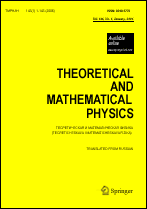|
This article is cited in 2 scientific papers (total in 2 papers)
The diagram theory for the degenerate two-orbital Hubbard model
V. A. Moskalenkoab, L. A. Dohotaruc, I. D. Chebotar'b, D. F. Digorb
a Joint Institute for Nuclear Research, Dubna, Moscow Oblast,
Russia
b Institute for Applied Physics, Moldovian Academy of
Sciences, Kishinev, Moldova
c Moldovian Technical University, Kishinev, Moldova
Abstract:
We investigate the minimal model that takes orbital degrees of freedom into account: the degenerate two-orbital Hubbard model. Our consideration includes the intraatomic Coulomb interaction of two electrons with opposite spins on the same orbital and on different orbitals and interorbital hopping of tunneling electrons. We take the influence of states caused by Hund's rule coupling on the metal–insulator phase transition into account. We generalize the diagram theory developed for strongly correlated orbitally nondegenerate systems to the case of orbital degeneration. For the one-particle renormalized Green's function, we establish an equation of Dyson type for calculating the system spectral function using a simple approximation based on summing chain diagrams.
Keywords:
strongly correlated electron system, Dyson equation, Green's function, degenerate Hubbard model.
Received: 09.02.2011
Citation:
V. A. Moskalenko, L. A. Dohotaru, I. D. Chebotar', D. F. Digor, “The diagram theory for the degenerate two-orbital Hubbard model”, TMF, 168:3 (2011), 490–502; Theoret. and Math. Phys., 168:3 (2011), 1278–1289
Linking options:
https://www.mathnet.ru/eng/tmf6696https://doi.org/10.4213/tmf6696 https://www.mathnet.ru/eng/tmf/v168/i3/p490
|


| Statistics & downloads: |
| Abstract page: | 423 | | Full-text PDF : | 186 | | References: | 46 | | First page: | 5 |
|




 Contact us:
Contact us: Terms of Use
Terms of Use
 Registration to the website
Registration to the website Logotypes
Logotypes








 Citation in format
Citation in format 
